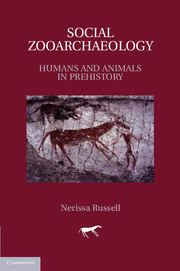Book contents
- Frontmatter
- Contents
- List of tables
- Preface
- 1 Beyond protein and calories
- 2 Animal symbols
- 3 Animals in ritual
- 4 Hunting and humanity
- 5 Extinctions
- 6 Domestication as a human–animal relationship
- 7 Pets and other human–animal relationships
- 8 Animal wealth
- 9 Meat beyond diet
- 10 Studying human–animal relations
- References
- Index
10 - Studying human–animal relations
Published online by Cambridge University Press: 05 June 2012
- Frontmatter
- Contents
- List of tables
- Preface
- 1 Beyond protein and calories
- 2 Animal symbols
- 3 Animals in ritual
- 4 Hunting and humanity
- 5 Extinctions
- 6 Domestication as a human–animal relationship
- 7 Pets and other human–animal relationships
- 8 Animal wealth
- 9 Meat beyond diet
- 10 Studying human–animal relations
- References
- Index
Summary
One ironic implication of post-processual developments is the increased need for better middle range theory. Middle range theory developed in the context of processual archaeology when it became clear that the quality of reconstructions of past behaviour was inadequate to fulfill the goals set by the processualists. Middle range theory has been developed through experimental, ethnoarchaeological and cross-cultural studies in order to provide tested links between archaeological data and past behaviour. Post-processual archaeology demands greater attention to the particular contexts in which past behaviours and actions occurred; consequently, post-processual approaches require better reconstruction of the past and place greater reliance on the development of middle range theory. (Driver 1997:81)
Having covered a lot of ground in the preceding chapters, a full summary would be difficult and probably not particularly useful. Rather I seek here to draw some general lessons from the topics examined for the practice of social zooarchaeology. What does it mean for our methods if we take seriously the social and symbolic aspects of animals and meat?
Some lessons
If nothing else, this review has yielded an abundance of cautionary tales for those seeking to model hunting and herding strategies. In addition to nutritional and economic factors, the balance of taxa and mortality profiles are quite likely to be influenced by the prestige or wealth value of the animal; by bridewealth, sacrificial, or feasting requirements; and by taboos and ethnic or other food preferences. Binford (1978) famously defined a number of utility indices (e.g., meat, marrow, and grease utility indices; general utility index) to aid in interpreting body part distributions, and others have added their own versions (Friesen 2001; Friesen et al. 2001; Garvey 2010; Jones and Metcalfe 1988; Lyman et al. 1992; Madrigal 2004; Metcalfe and Jones 1988; Monks 2004; Morin 2007; Olivera and Nasti 2001; Outram and Rowley-Conwy 1998; Rowley-Conwy et al. 2002; Savelle and Friesen 1996; Savelle et al. 1996). For the most part, these indices treat utility in nutritional terms, although James Savelle (1997) has offered an architectural utility index for whale remains. However, in addition to forces of attrition that affect body part distributions, which have been extensively studied by Binford and others, human selection of bones for trophies, special deposits, hunting shrines, respectful disposal, divination, and other uses may shape our assemblages. Skulls and horns, generally rated as low-utility body parts, are particularly likely to be transported, curated, and displayed to commemorate hunts, sacrifices, or feasts (e.g., Russell and Martin 2005).
- Type
- Chapter
- Information
- Social ZooarchaeologyHumans and Animals in Prehistory, pp. 395 - 400Publisher: Cambridge University PressPrint publication year: 2011



